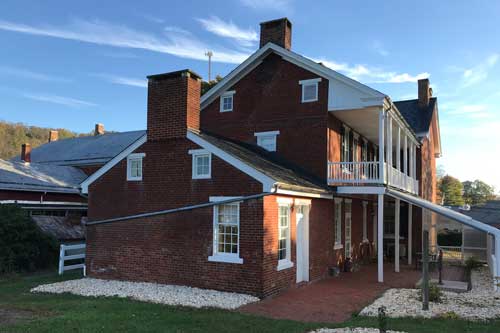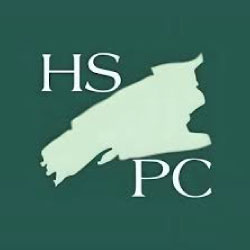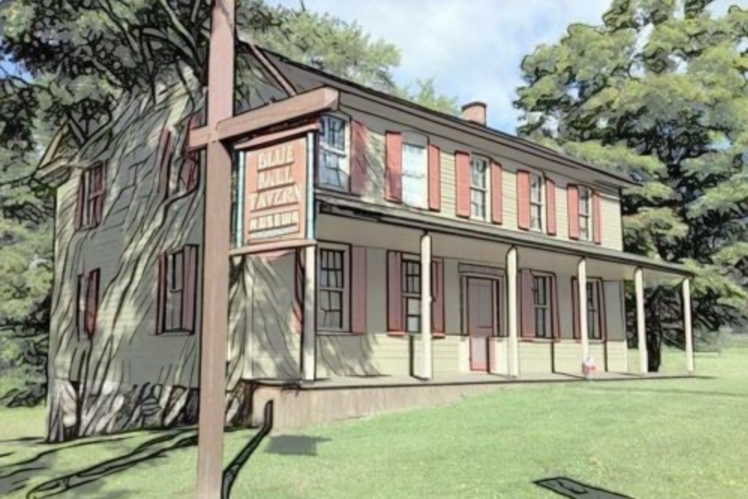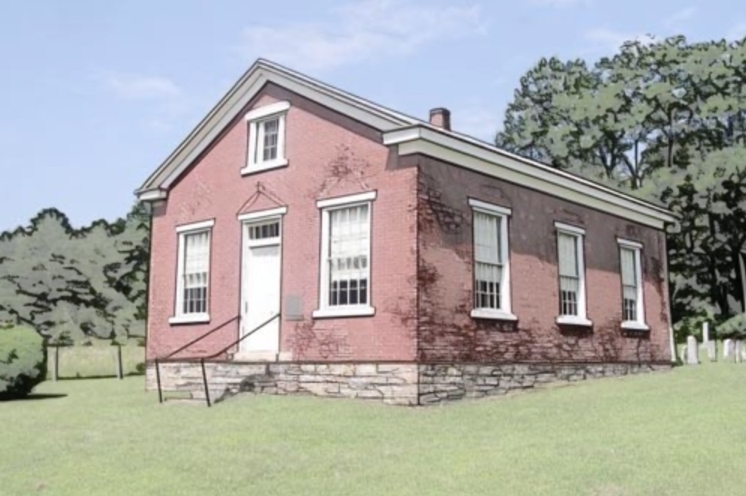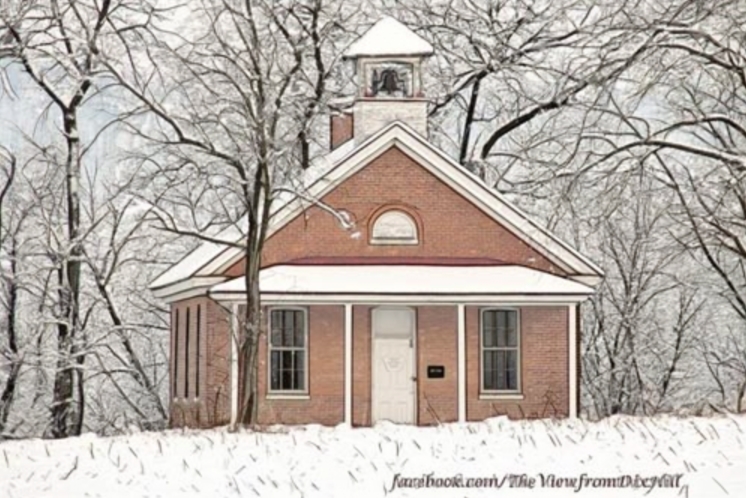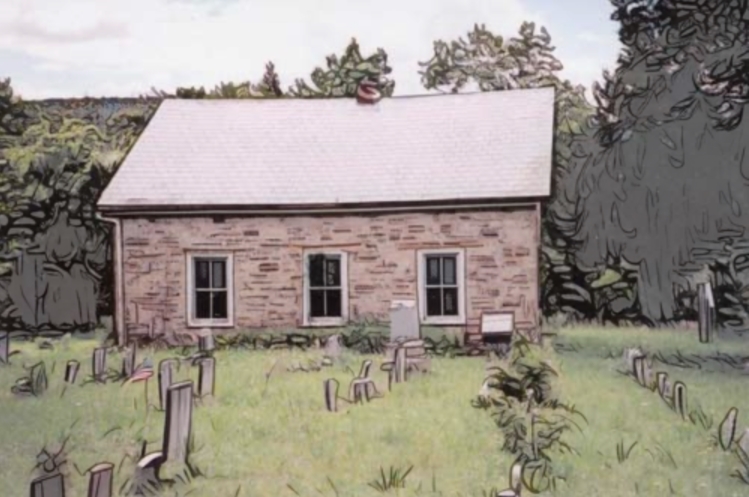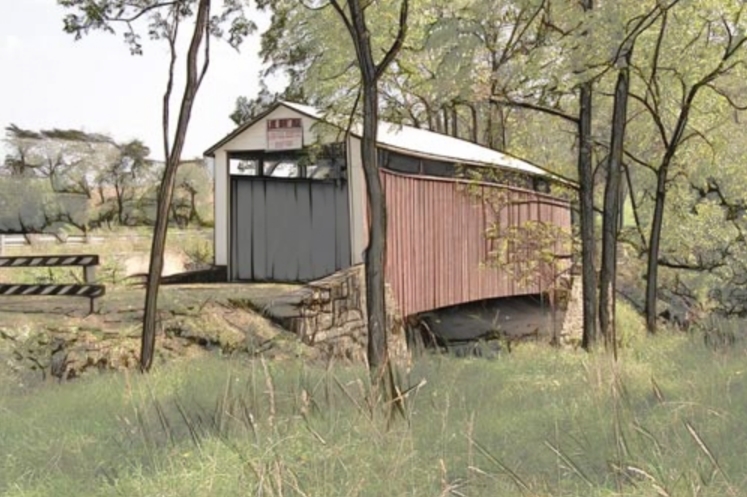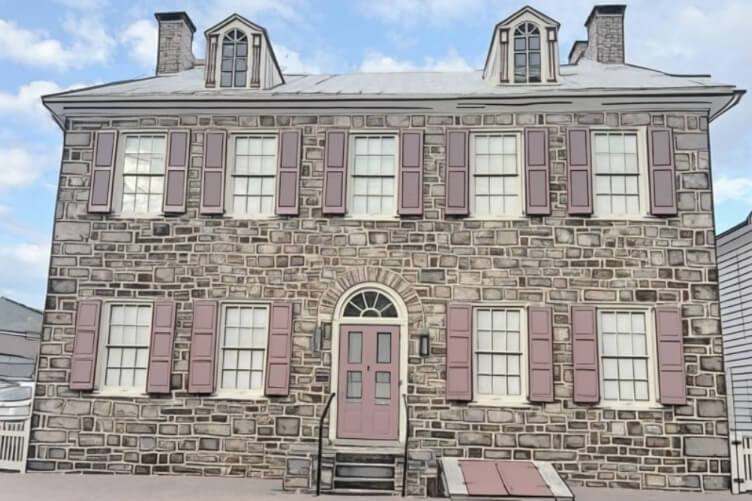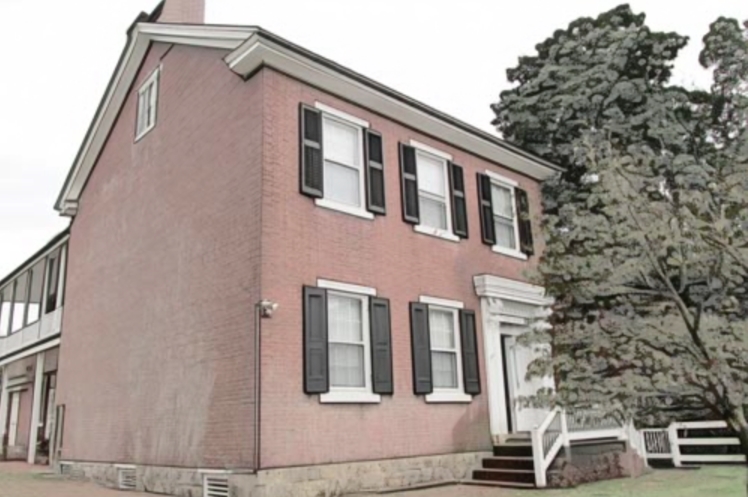Visit Historic Properties in Perry County, PA
The Historical Society of Perry County preserves and maintains eight unique properties, each one with its own fascinating story. With the help of our many members and volunteers, we are able to welcome the public to learn about these historic properties and the people who once lived, worshipped, learned, or worked there. Click on each image below for more information.
Blue Ball Tavern
Dromgold Farm
Fairview Church
Green Park School
Ludolph Church
Red Bridge
The Cochran-Anspach House
The Fetter House
Blue Ball Tavern
Newport, PA
William McCroskey was warranted 237 acres, 94 perches, located in Rye Township, Cumberland County, PA, on June 2, 1762. William, his wife Ruth, and children, William Jr. and Elizabeth remained in Carlisle, but they made improvements on the land and rented it out. William died in 1774 without a will and his children were both minors. As such, on November 20, 1777 the land was offered at public sale. The following improvements were listed in the advertisement: house, orchards, and meadows. John Riddle, a carpenter and resident of Rye Township bought the property and owned it from 1777 through 1790.
Continue Reading...
Pete Koch, Sr. purchased the property from Riddle and was living there in 1793 when assessment records indicate that Peter was operating a saw mill. Early in the year 1795, Peter Koch, Sr. died. His will, dated January 22, 1795, stated that the land was to be rented to the highest bidder, but his wife Margaret, could live on the property. The land was rented to George Thomas who later married Margaret Koch. The two-story house, built of wood, had seven windows with 78 lights. The tax listed only one dwelling house and the value was put at $250.00 John Koch remained on the land and made agreements with his mother, sisters, and brother to purchase their shares. He continued operation of the saw mill and also farmed. John opened a tavern at the “SIGN OF THE BLUE BALL” before the end of the year 1811. Several roads intersected and the Juniata Iron Furnace, a furnace operated by William Power and David Watts began in 1808. As such the “Blue Ball” enjoyed a brisk trade and became a stopping place for dispatch riders during the War of 1812.
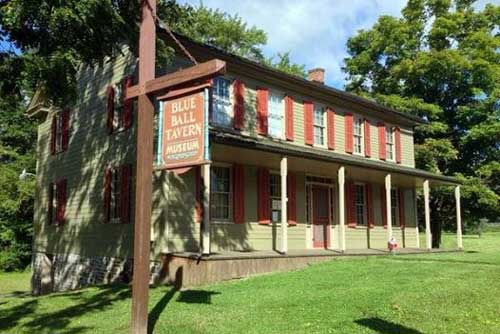
Perry County was organized on March 22, 1820 from part of Cumberland County. A meeting at the home of John Koch on Wednesday, October 4, was held to select persons to run for political office in the new county. The Juniata Division of the Pennsylvania Canal was built in 1823-1824 and many canal workers spent their evenings at the Blue Ball. The Juniata Furnace was leased to John Everhart, who rebuilt it and erected a large forge in 1825. Additional workmen were employed and also spent their evenings and pay at the Blue Ball. A gristmill was built on the land adjoining the John Koch property about 1833-1834. John was operating a saw mill on his property in 1833. He discontinued operation of the tavern in April 1841, but continued to take in overnight lodgers. John became involved with the church in 1842 and this may have prompted his temperance ideals and decision to stop keeping the tavern.
Sulphur Springs Christian Church, also known as Kough’s or Rodebaugh’s Church, was located on land John sold to the church for $1.00. John Koch found himself in financial trouble in 1847 and was forced to sell the property. The deed book states his holdings as a mansion house, double log barn, sawmill, cupola, two tenant house, stables, blacksmith shop, spring house and other out-buildings, as well as an apple orchard. John’s son, William, bought half interest in his father’s property at a Sheriff’s Sale held in January of 1848. The Newport to Bloomfield road, surveyed in 1833, relocated the road from in front of the Blue Ball (the back of the present structure) to the rear of the building. The small fording, directly south on Little Buffalo Creek, was abandoned and a bridge built just east of the fording. William and John Koch received sixty-five dollars’ damage when this new road opened through their property in the summer of 1849.
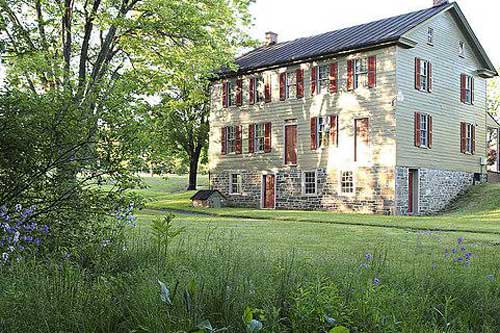
Between 1850 and 1860 William and John decided to build two new houses on each of their properties. John removed the upper wooden structure of the Blue Ball and built a new frame house facing the new road. William built an identical house further down the road toward Newport. When the first structure was torn down, John’s new house was built on the old foundation, where the old tavern was located. The original basement had three rooms. One served as the tavern proper, while the other served as a cooking and dining area. The third small room served as a cold cellar and storage room. Part of the original foundation is built on a rocky ledge because it was too hard to dig out. Several basement windows are original to the earliest days of the tavern with rounded white-washed corners to let in more light.
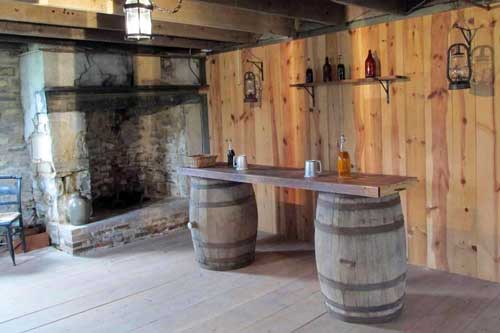
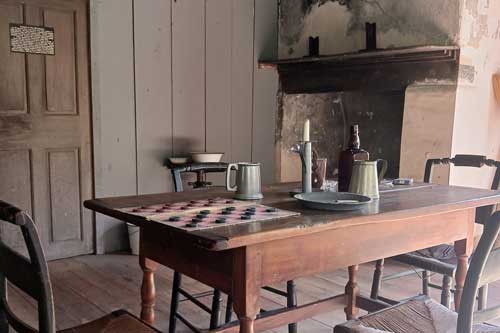
John’s wife Eleanor died on September 25, 1856 and the age of 68. John remarried and his wife Mary Ann died in 1862 at the age of 60 years. John Koch died on July 9, 1867 at the age of 79. All three are buried at Sulphur Springs Church, just north of the tavern. The farm was known for many years as the “Sulphur Spring Farm,” because of the sulphurous smell of the water. The weather frame structure (now replaced with a board and batten structure) to the rear of the building was built about 1800, onto a stone chimney which had stood many years before that. This chimney is believed to be the oldest construction on the property. The stone structure is a spring house where food was kept cool in the running water while the second floor double as a smoke house.
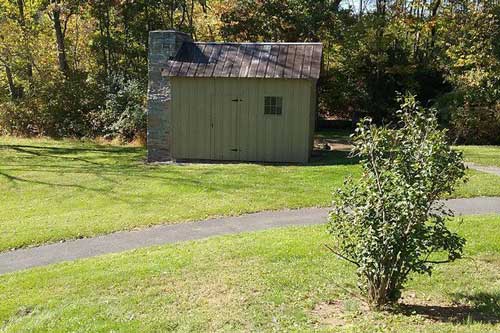
Dromgold Farm
Shermans Dale, PA
Homesteaded in 1828 by Benjamin Cunningham, Gladys Dromgold Schaffer’s great-great-grandfather, the farm remained in the Cunningham/Dromgold family until Mrs. Schaffer bequeathed it to the Historical Society in 2009. It was recognized as a Century Farm by the PA Department of Agriculture in 1991.
Continue Reading...
The property was the site of a tannery, blacksmith’s shop, general store, post office and the Natural Beauty Park. It was also a stop for the stagecoach which ran between Landisburg and Carlisle. The crossroads of PA Routes 34 & 850 was a key stopping point on the old Allegheny Trail, the road to America’s western frontier. For many hundreds of years before that an Indian trail known as New Path ran from Letort’s Spring at Carlisle, over Croghan’s Gap, past Dromgold & Fort Robinson, over Tuscarora Mountain to Aughwick. Mrs. Schaffer remembered her grandfather trading with the Indians passing through.
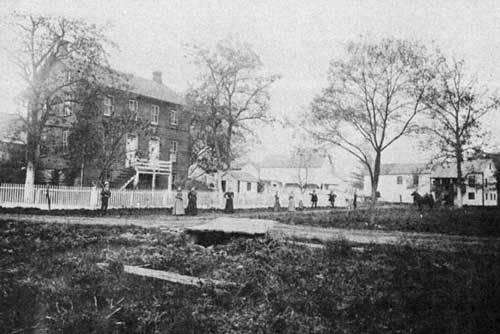
The 113 acre property today contains two houses, a hunting cabin, barn, chicken house, garage, spring house & wagon shed. The present day wagon shed is built on the site of the old tannery.
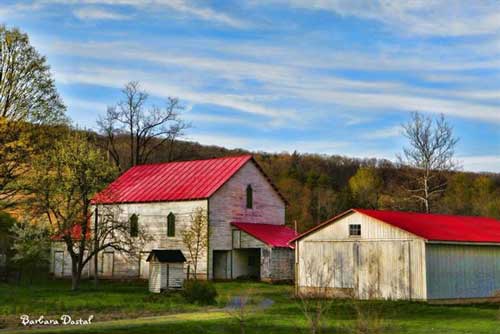
As many as seven dwellings were once on the property to house family and workers. The tannery operated from about 1874 to 1894, the post office from 1897 to 1905, the Natural Beauty Park from 1928 to WWII, the blacksmith shop until 1948 & the general store until the mid-1970s.
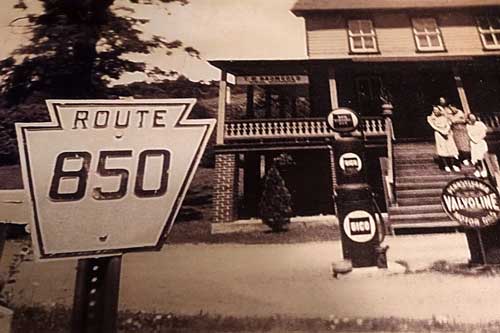
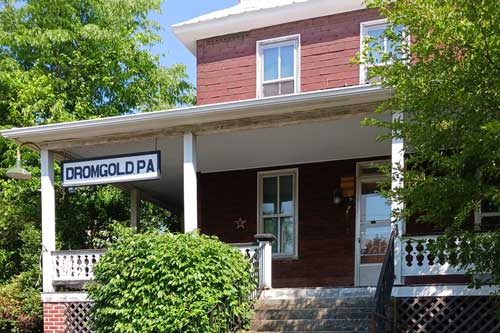
Fairview Methodist Episcopal Church
New Germantown, PA
Fairview Methodist Episcopal Church is located approximately 4 miles west of New Germantown at the far western end of Perry County. Ephraim A. McLaughlin, a Scotsman and a native of Franklin County, crossed over the mountain from Concord and purchased several tracts of land in March of 1850. On January 3, 1857, an indenture was signed between Ephraim and Lucinda, his wife and Rev. David Shaver, E. A. McLaughlin, John Shearer, Jeremiah Rowe, David Moreland, James Enslow and Jacob Bixler–Trustees, for the purchase of a lot of ground containing 36 perches. The sum agreed upon was $20.00 upon which would be built a Methodist Church. The deed was recorded on Feb. 5, 1857.
Continue Reading...
In addition to the previous names, church membership included families of Peter Beichler, Jonathan and Silas Colledge, G. W. Martin and James McLean. Later members included the O’Donnels, Gutshalls, Bowmans, Hopples, Trostles and Adamses.
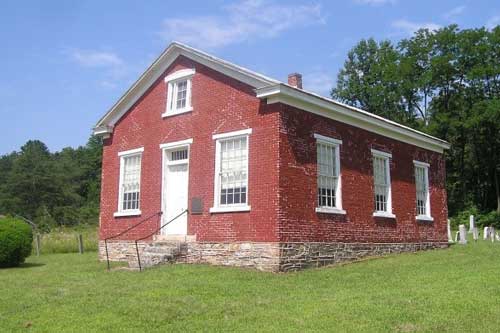
Stones for the church foundation were hauled from the surrounding mountains and brought to the site where they were faced and laid. Clay for the bricks was obtained from the bank of Sherman’s Creek and baked in the field across the road, (as were the bricks for the nearby McLaughlin home). Brick-making was not conducted on a regular basis this far west in the county, as these two buildings are the only ones made of brick west of New Germantown. The timbers, flooring, pews, and altar for Fairview Church were made of wood from a nearby sawmill. The kerosene lamps were probably purchased from stores in Blain or Concord. Firewood for the stove was furnished by the parishioners.
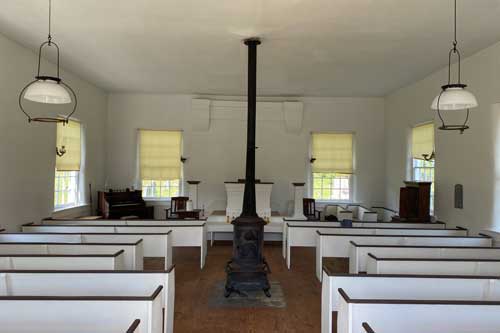
Most of the members were farmers although some were employed as laborers in the sawmills, the McLaughlin tannery, or at the Lehman or Blemel grist mill. Farms were common within the hollows of the surrounding mountains and at one time the population of Toboyne Township was over two thousand people. Today, it is around 600 and the farms in the hollows are overgrown with trees, though many foundations are still visible.
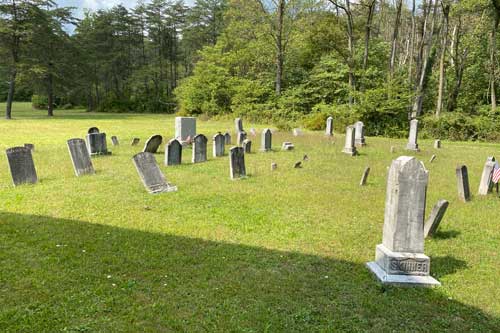
Green Park School
Elliottsburg, PA
The clanging of the school bell, a boisterous game of Fox-and-Geese, the rhythm of a poetry recitation, chalk on slate, and evening declamations of the literary society are sounds no longer heard at the numerous one-room schoolhouses that once dotted Perry County. Although nearly all these relics of bygone days have either disappeared or been adapted to other uses, there is an opportunity to re-capture this lost history by a visit to a site in Perry County that boasts a long tradition of education: Green Park one-room schoolhouse.
Continue Reading...
The history of this community reveals a steadfast commitment to the education of its children. The Historical Society of Perry County continues to preserve the Green Park one-room schoolhouse as a walk-in time capsule with artifacts from a much simpler time. But there is more to this story than bricks and mortar, for it is the students and teachers that made it a school. Their stories breathe life into the now empty schoolhouse and give us a window on the past as we move into the future.
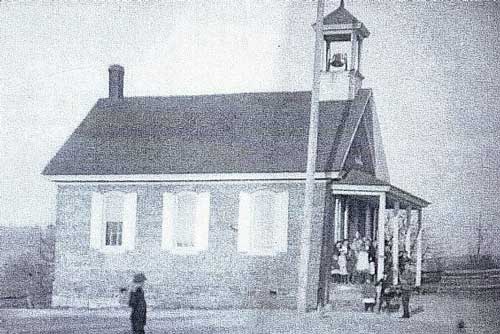
It was an austere beginning in 1815, when a log schoolhouse was first constructed near Rheem’s Foundry at Green Park, just west of the present-day brick schoolhouse. 1842 saw the building of the first school at the site of the present Green Park schoolhouse, the land being donated by Martin Bernheisel. By 1854, there were a total of 35 scholars (as they were called in those days). Subjects included orthography (spelling), reading, writing, arithmetic, geography, and grammar. Teacher reports of the period offer a glimpse into the workings of the school: The teacher did not agree with the practice of recording punishments, feeling that they were better forgotten; the teacher felt appreciated when he received approving smiles from parents; the teacher felt that parents and pupils both had too great of a veneration for old and outmoded methods of instruction. In 1859, Professor (as teachers were commonly called) J. Kretzing was paid $20 per month. In that year, a new blackboard was installed and there were some complaints from parents when several students were punished with the rod.
The first brick schoolhouse built in 1842 served the community for 38 years until it was destroyed by fire in 1880. A crowd of about half a dozen residents watched helplessly as it was consumed by flames around 11 at night. It was believed that the stove was the culprit. After a $1,048 reconstruction that same year, the superintendent declared that “Green Park in Tyrone is risen Phoenix-like from the ashes.” Adversity had tested the commitment of Green Park to its children, but the community was not found wanting.
In 1886, a mere six years after the devastating fire, tragedy struck again. At 2 AM, fire was discovered by a nearby neighbor and the door was forced open, but the collapse of the chimney blocked further entrance to the structure. A large crowd watched until only the brick walls were left standing. As with the last fire, there was no insurance. Rebuilding cost $1,801, including an iron bell that was cast at Rheem’s Foundry in Green Park. This is the building that stands preserved today with its original bell. A new school had again risen from the ashes.
By 1891, the school was thriving, with an enrollment of 48 scholars. Two years later, Newton J. Briner purchased the farm on which the school sets from Martin Bernheisel, who had originally donated the land. Newton Briner farmed the 185 acres and taught at the school until both tasks became too much and he eventually devoted himself solely to farming. An eyewitness to this time period was Edgar Stambaugh, who attended the school from 1894 to 1905 (age 7 to 18). He recalled memorizing poetry, including Longfellow, who became his favorite. Games in the spring included Fox-in-the-Morning, Chickens-are-early and Fox-and–Geese. The smell of apple or tomato butter bread was common during lunch. Spelling bees were held, and a literary society, emphasizing public speaking, met at the school in the evenings. “We learned very much more from watching the older pupils, than from the teacher…We watched them recite and we got a lot of things from them.”
In 1929, Helen Briner began her teaching career at Green Park’s one room school, serving longer there (by far) than any other teacher. The school has a special place in the Briner family history, as her father, Newton Briner, had purchased the property from the original donor and had taught at the school for four years. Helen first attended the school in 1912, completing grades 1-8, and throughout her long career at Green Park, she taught 8 grades. Helen related how she would arrive at 7 AM to make the fire, carrying the wood herself. The children would obligingly carry water from down at Green Park even in the winter, appreciating the time out of class.
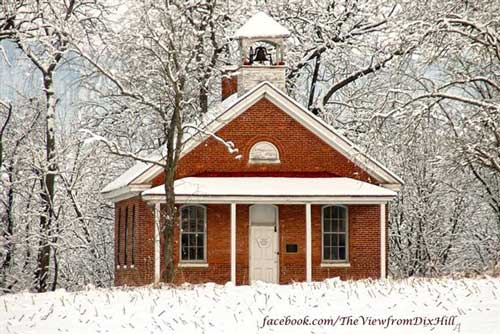
Sally Coldren Hebbe was a student at Green Park at this time and she remembered how there was no electricity, so on cloudy days, school would be cancelled to avoid eyestrain. Spring recess included fishing in the nearby stream, while sledding was popular in the winter. Either way, the students often returned wet and Miss Briner would hang their clothes to dry near the “big old furnace,” while the students sat wrapped in blankets. It didn’t take long for the students to realize that if they were wet to the skin, that Miss Briner would have to send them home. Sally fondly remembered the fun involved in going to and from school. They would often ride their bikes, stopping at Eddie Garlin’s store for a piece of candy.
Fay Freeman Wilson attended grades 1-8 and paints a picture of life at the school from 1932-1940. She remembers that after the school bell summoned students to take their seats, they would start the school day with the “Pledge of Allegiance,” a prayer, and some songs. Students were generally well-behaved except for occasional mischief and she recalls that her teacher, Miss Briner, was a reluctant disciplinarian. There was recess in the morning and afternoon, with baseball being a popular pastime on the west side of the school, with the flagpole serving as home plate. To get to school during snowy days, Fay would ride to school in a horse-drawn sleigh owned by the Dum family.
In 1949, with the consolidation of schools under the Green Park Union School District, the one- room schoolhouse at Green Park would transition from grades 1-8 to instructing only grades 5 & 6. Robert Owen would teach the last class at the brick schoolhouse in 1954. Like Helen Briner, he would have a distinguished teaching career in Perry County.
The little brick schoolhouse at Green Park was reincarnated in 1969. The building, all its contents, and .34 of an acre of land were deeded to the Historical Society of Perry County by the West Perry School District for $1. Attending the ceremony was Robert Owen, the school’s last teacher. The interior of the school remained much as it did when he served as its last teacher. L. Dana Rice expressed the sentiments of the historical society: “We’d like to keep the school in a reasonable degree of repair, preserve it for future generations, because when some of these old landmarks are destroyed in years to come, we won’t know what a little red school house looks like.” The preservation of the little red schoolhouse prompts us to compare this bygone era to our present educational system and helps us see what we have lost and what we have gained. History, then, is not only about the past, but also about making a better future. This is a valuable lesson that the historical society teaches us through its preservation efforts at Green Park.
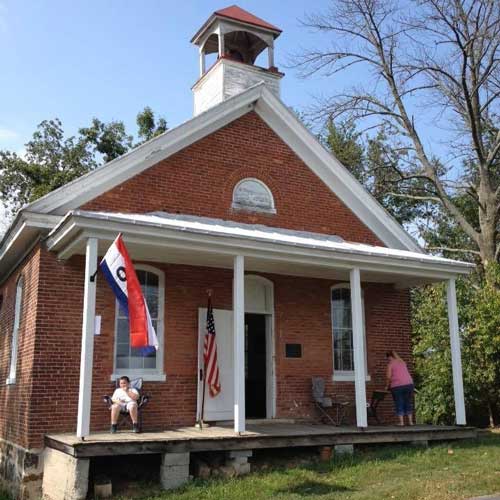
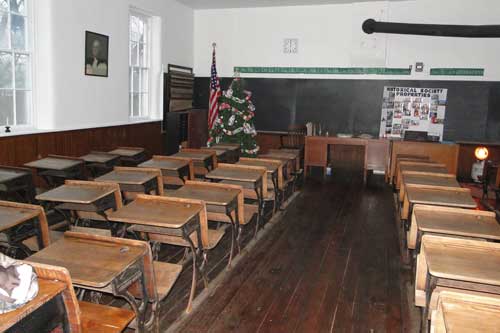
Ludolph Church
Elliottsburg, PA
As early as 1780, a number of German immigrants settled in what is to this day known as “Little Germany”. Immediately after establishing their farms and a church they began seeking formal education for their children. The first school was a subscription school housed in the home of Henry Ludolph Spark, a German schoolmaster of the Lutheran faith. Sometimes he preached as a lay minister and conducted baptisms as well. Upon his death in 1803, he bequeathed his house and land, totaling seventeen acres, for the use of the education of “his neighbor’s children.”
Continue Reading...
After Spark’s death, Mr. Isaac Carl became schoolmaster and taught at the school for some twenty years. Carl’s Schoolhouse, as it became known, stood about 50 yards southwest of Ludolph Church.
In 1790, the Rev. John Timothy Kuhl, an Evangelical Lutheran minister, moved into Sherman’s Valley and became the first pastor of the Lutherans. They held services in Carl’s Schoolhouse for a number of years. In 1831, a second building was erected at almost the same location. The Rev. John W. Heim of the Lutheran faith and Rev. Jacob Scholl of the Reformed faith held services there. Rev. Heim was a circuit riding minister and held services at churches, schools, and in homes throughout Perry County. The Rev. Heim was called the “Father of Lutheranism” in the county.
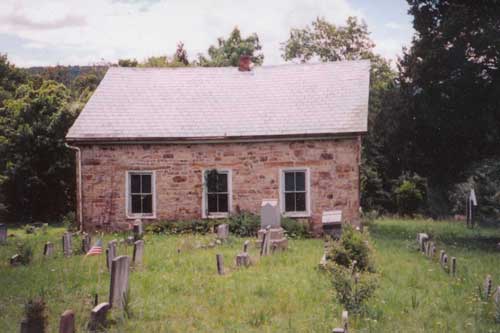
Both the Lutherans and Reform congregations continued to use the school house for worship until the late 1830’s, when the two groups jointly decided to build a church near the school. As plans to build were under way, one of the preachers resigned and moved to New Bloomfield putting the building plans on hold. Finally in May, 1841 the cornerstone was laid for a stone church that was completed in November, 1842 on the land of Henry Ludolph Sparks. It became known as “Stone Church” and later “Ludolph’s Church” in his honor.
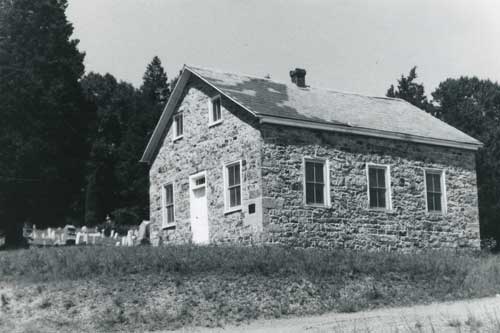
Each group met in the church on alternate Sundays beginning in 1842. As the decades wore on, more people began settling in the village of Elliottsburg and by 1866, the Lutheran congregation decided to build a new church there. This congregation was incorporated on January 7, 1867. The congregation kept the name “Ludolph” and the new church was known as the Ludolph Evangelical Lutheran Church.
The Reformed congregation abandoned the church in 1872 when they also built a new church in Elliottsburg.
In 1911 Mr. George Gehr left $400, in his will, to the original “Ludolph” church with $20.00 being for repairs and $380.00 for the care of his and his parents graves. Also, the will stipulated a service being held there every 25 years to honor them. This money was put into a trust fund but never used and eventually turned over to the Historical Society of Perry County in 1976.
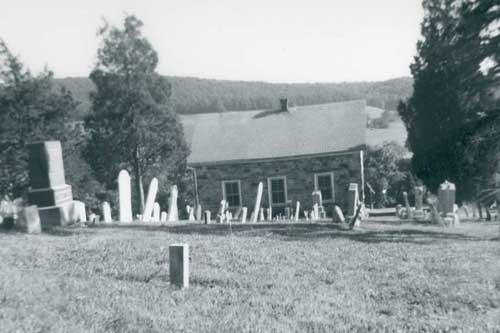
The Historical Society acquired the church in a transaction from the Trustees of the Lutheran Church in Elliottsburg in 1954, for the sum of $2.00, as recorded in Deed Book 149, Page 226 at the Perry County Court House.
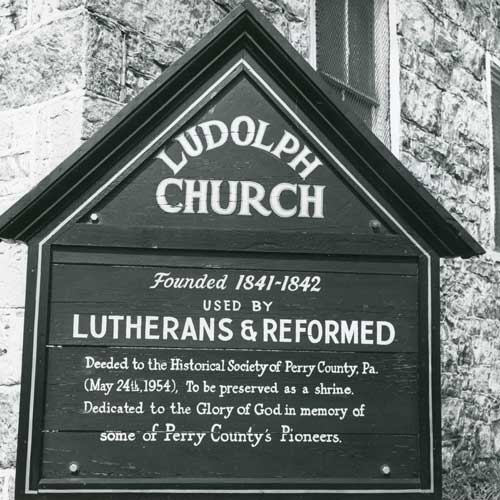
Ludolph Church today stands as a reminder of Perry County’s educational and religious history-a silent monument hearkening to the 1780 subscription school and seventeen acres donated for the “education of my neighbor’s children” by Henry Ludolph Spark.
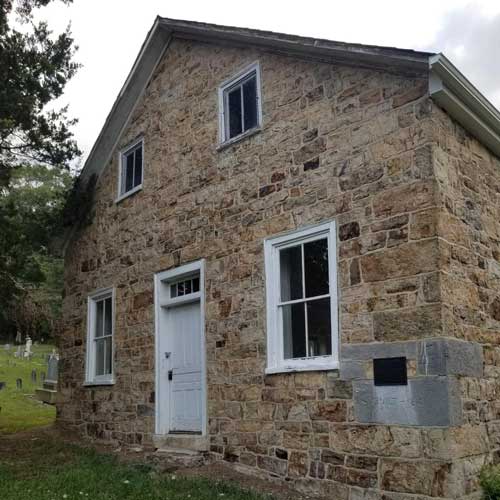
Red Bridge
Liverpool, PA
Red Bridge is located in Liverpool Township, along Red Bridge Road, just a mile west of US Routes 11/15 near Liverpool. The bridge, which was built in 1886 crosses Barger’s Run. Red Bridge measures 55 feet in length by 15 and a half feet wide. It is the only king-post/queen-post style covered bridge remaining in Perry County and the only covered bridge east of the Juniata River in Perry County.
Continue Reading...
The bridge was given to the Historical Society in 1961 when the Commonwealth built a new two lane bridge adjacent to it, to accommodate increased traffic and heavier loads. The abandoned roadway was turned over to Liverpool Township, allowing access to the bridge. The bridge was listed on the National Register of Historic Places in 1980.


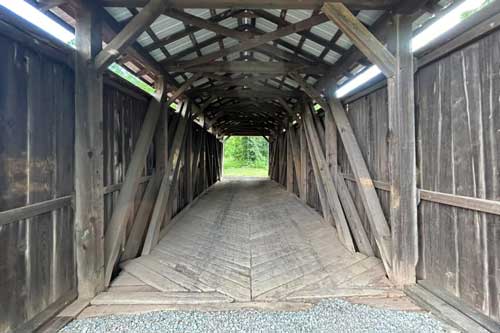
The Cochran-Anspach House
Millerstown, PA
The Cochran-Anspach House was built in 1821 by Isaiah Clark, for Thomas Cochran, one of the first settlers and a larger landholder in Millerstown. This was the third stone house Mr. Cochran had built in town.
Continue Reading...
Thomas Cochran was born in 1776 in Londonderry, Ireland. Thomas and his three brothers purportedly owned large tracts of land, but because they were Protestant, chose to leave Ireland and come to this country. Thomas arrived in Millerstown by 1798.
Records state that Thomas Cochran was “an elegant looking gentleman of courteous and pleasant manners and an excellent penman.” In 1802, he married Sophia Maria Porter of Lewistown, who was also born in Londonderry in 1776. The couple would have six children together.
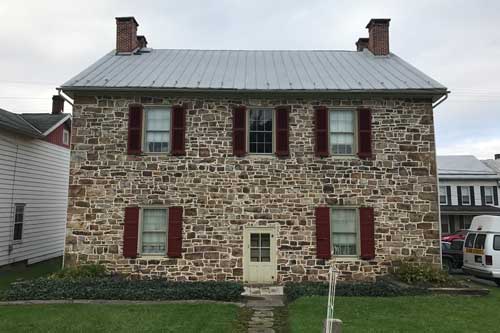
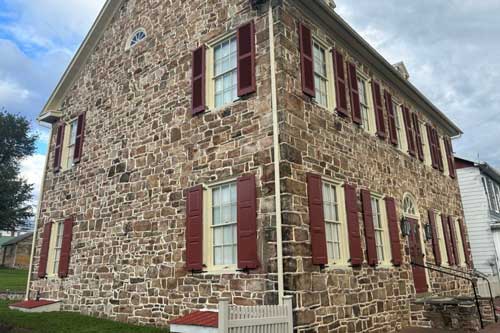
The first stone house constructed in Millerstown by Cochran was the present VFW house which was completed in 1801. Here Cochran kept a store and post office, as well as an inn known as the “Cochran Hotel.” The first sermon preached in Millerstown was by Reverend John Hutchinson of Mifflintown in the barroom of the hotel in 1806. It was the beginning of the Millerstown Presbyterian Church which was later built in 1831-32 on lands donated by Thomas and Sophia Cochran.
Cochran built his second stone house, on the northeast side of the square, in 1813. He kept store in the house beside this second house until 1834. When Thomas Cochran died in 1846 at the age of seventy, he had vast holdings of land in Pennsylvania and Missouri, as well as stock in a Harrisburg bank.
According to his will, Thomas Cochran bequeathed the stone dwelling in Millerstown, “all household furnishings, his riding horse and barouche, two milch cows, and the income from 200 shares of bank stock to his wife during her natural life.” At her death the furnishings were to be divided among his children and “none else.” His other holdings were willed to his surviving children. To his son, Thomas Preston Cochran, he bequeathed his farm in Pfoutz Valley, also the Daniel Hoffman farm, the stone house in Millerstown on the death of his mother, his church pew #56 and another pew #2, which was for the use of his mother and family.
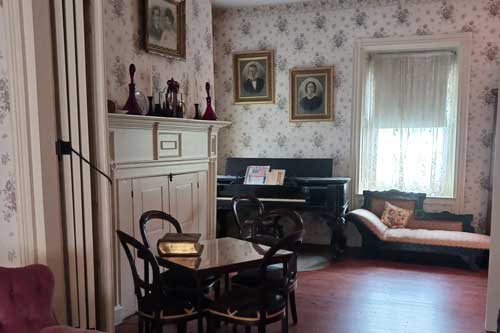
Thomas Preston Cochran was born in Millerstown in 1813. His primary education was at the common schools of Millerstown which he attended until the age of ten. He then attended a preparatory school prior to entering Jefferson College. Due to failing eyesight he returned home after graduation and became a clerk in his father’s mercantile business. On his father’s retirement in 1835, Thomas Preston succeeded running the establishment and became a successful merchant.
Later in life, Mr. Cochran disposed of the store and bought a farm in Greenwood Township where he busied himself in agriculture and mining pursuits. In the course of time, he acquired seven farms. In 1864 he retired from actively running the mercantile business, selling all but two farms but still managing his iron ore interests.
Thomas P. married Jane Patterson of Juniata County in 1835. She died in 1836 leaving a son Robert P. Cochran. In 1839 Thomas married Rebecca Black of Tuscarora Township who died about 1884 leaving five children. In 1886 Mr. Cochran married Hannah Maria Kauffman, a widow from Juniata County. After Thomas’ death, the property passed to Hannah, whose son Charles A., purchased it in 1916 later passing to his daughter Anna Kauffman Anspach (born 1883), wife of Irvin Anspach, a druggist from York Haven. Their son Irvin Kauffman was born in 1909. Anna and Irvin Kauffman, Sr. divorced in 1922. Kauffman and his mother lived in Harrisburg until returning to Millerstown in the 1950s. Upon his mother’s death, the property passed to Kauffman. Irvin Kauffman worked in Harrisburg for many years, but lived in the stone house in Millerstown until his death in 1981.
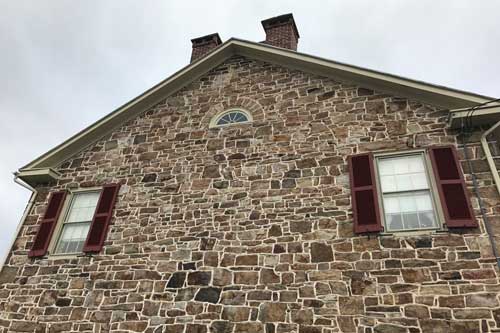
The Fetter House
Landisburg, PA
This lovely old brick home in the heart of Landisburg was built by Henry Fetter in 1848. It is now owned by the Historical Society of Perry County having been deed to them by Mr. Fetter’s great, great granddaughter, Mrs. Marjorie Goosens.
Continue Reading...
Henry Fetter was one of the merchants doing business here when the County of Perry was formed. He would take several wagons and proceed to Baltimore for merchandise with which he stocked his store and the balance he would sell to other merchants in Perry and Juniata Counties.
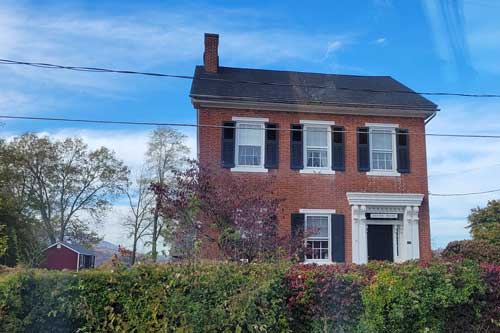
Fetter, on his excursions to Philadelphia and Baltimore, would pick up unemployed people who needed work and bring them back to Landisburg where they helped in the building of the house. The interior contains beautiful millwork and paneling. When it came to building the stairway no one was available with the necessary know how until a down and out builder, who might be referred to as a tramp, happened along. He drew up the plans, told the workers how it should be installed, and then went on his way. His plan was followed and the result is a charming wide stairway which goes all the way to the third floor.
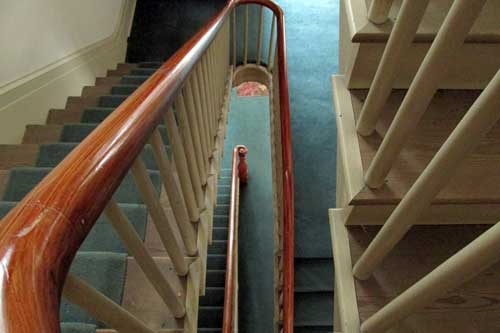
In 1823 Mr. Fetter served as the second postmaster of Landisburg and in 1825 was elected County Auditor. In 1831 he was a member of the Board of Trustees of the first school. One July 4th, 1826, when the 40th Anniversary of American Independence was celebrated in Landisburg, the Landisburg Artillery Corp was under the command of Captain Henry Fetter. He was also elected Captain of the Perry County Reserves of Home Militia in the 1840’s. In 1857 he was elected to the PA Senate and served a three year term of office. It was Henry Fetter who gave the land on which the Trinity Reformed Church was built.
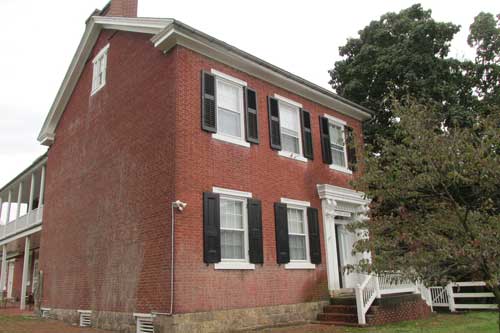
In the Fetter house, there were tall grandfather clocks on the stairs, in the drawing room, the library and the kitchen, all of which must synchronize in their striking and chiming, as must also the smaller clocks on the shelves in the upstairs apartments. Some of the huge eighteenth century watches also had sweet musical chimes in minor key, while all types of sundials had to be adjusted.
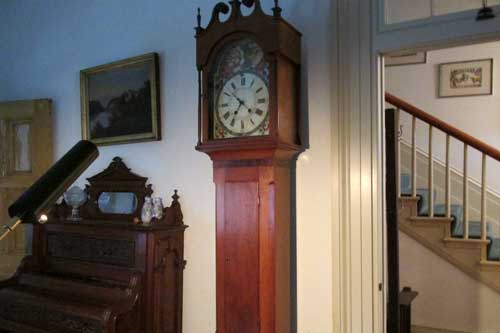
In an article written in 1939 by Henry W. Shoemaker entitled “Perry County Watch and Clock Makers,” he quotes noted historian J. W. Sheibley as saying, “In the old days these traveling watch and clock makers would often spend the winter in a mansion like the Fetter house where there were scores of tall clocks of all kinds to be repaired.”
One clockmaker, an Austrian, after completing his work at the Fetter mansion proceeded to Selinsgrove by way of the old Landisburg-Clarks Ferry Road and when in the vicinity of Page Hill, just south of New Bloomfield, was apparently waylaid by the notorious Page brothers of the Cumberland Valley and was never heard of again. “The old clockmakers who came to Harold Ickes’ land, as many called Perry County,” says Mr. Sheibley, “made the clock wheels out of apple, pear, and persimmon wood. They always carried strips of these woods, all carefully dried and cured.” Old General Fetter, as he was called, would today be called a “clock fancier,” but it is a bit of folklore that when he lost his beautiful daughter, all the clocks in the house stopped simultaneously.
This charming girl was the belle of the inaugural ball at Harrisburg, held at the old “Eagle Hotel,” and danced so many times as to be in perspiration. When she left to return to the Simon Cameron home on Front Street, where she was staying, she took a chill and upon her return to Landisburg, took to her bed and died.
General Fetter’s sword and his desk with its thirteen windows in each door, signifying the thirteen original colonies, and his fine old mahogany fiddle back chairs are now in the possession of the Historical Society of Perry County. The late Mrs. William J. Fetter of Carlisle, donated the chairs.
Henry Fetter was a trustee of a school authorized by a special act of the Pennsylvania Legislature on June 12, 1840 designated as “a female seminary or public school for the education of female youths in the English or other languages, the useful arts, sciences, and literature by the name, style, and title of the Landisburg Female Seminary.” This school was located at Alinda about one mile northeast of Landisburg in the former Judge Junkin home.
Henry Fetter died in December 1863 and is buried in the Landisburg Cemetery.
